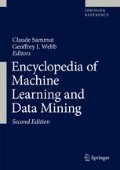Access this chapter
Tax calculation will be finalised at checkout
Purchases are for personal use only
Recommended Reading
Ade H, Denecker M (1995) AILP: abductive inductive logic programming. In: Mellish CS (ed) IJCAI. Morgan Kaufmann, San Francisco, pp 1201–1209
Ade H, Malfait B, Raedt LD (1994) Ruth: an ILP theory revision system. In: ISMIS94. Springer, Berlin
Alrajeh D, Ray O, Russo A, Uchitel S (2009) Using abduction and induction for operational requirements elaboration. J Appl Logic 7(3):275–288
Bergadano F, Cutello V, Gunetti D (2000) Abduction in machine learning. In: Gabbay D, Kruse R (eds) Handbook of defeasible reasoning and uncertainty management systems, vol 4. Kluver Academic Press, Dordrecht, pp 197–229
del Cerro LF, Inoue K (eds) (2014) Logical modeling of biological systems. Wiley/ISTE, Hoboken/London
DeJong G, Mooney R (1986) Explanation-based learning: an alternate view. Mach Learn 1:145–176
Doncescu A, Inoue K, Yamamoto Y (2007) Knowledge based discovery in systems biology using cf-induction. In: Okuno HG, Ali M (eds) IEA/AIE. Springer, Heidelberg, pp 395–404
Flach P, Kakas A (2000) Abductive and inductive reasoning: background and issues. In: Flach PA, Kakas AC (eds) Abductive and inductive reasoning. Pure and applied logic. Kluwer, Dordrecht
Flach PA, Kakas AC (eds) (2009) Abduction and induction in artificial intelligence [special issue]. J Appl Logic 7(3):251
Inoue K (2001) Inverse entailment for full clausal theories. In: LICS-2001 workshop on logic and learning
Ito K, Yamamoto A (1998) Finding hypotheses from examples by computing the least generlisation of bottom clauses. In: Proceedings of discovery science’98. Springer, Berlin, pp 303–314
Josephson J, Josephson S (eds) (1994) Abductive inference: computation, philosophy, technology. Cambridge University Press, New York
Kakas A, Kowalski R, Toni F (1992) Abductive logic programming. J Logic Comput 2(6):719–770
Kakas A, Riguzzi F (2000) Abductive concept learning. New Gener Comput 18:243–294
King R, Whelan K, Jones F, Reiser P, Bryant C, Muggleton S et al (2004) Functional genomic hypothesis generation and experimentation by a robot scientist. Nature 427:247–252
Leake D (1995) Abduction, experience and goals: a model for everyday abductive explanation. J Exp Theor Artif Intell 7:407–428
Michalski RS (1993) Inferential theory of learning as a conceptual basis for multistrategy learning. Mach Learn 11:111–151
Moyle S (2002) Using theory completion to learn a robot navigation control program. In: Proceedings of the 12th international conference on inductive logic programming. Springer, Berlin, pp 182–197
Moyle SA (2000) An investigation into theory completion techniques in inductive logic programming. PhD thesis, Oxford University Computing Laboratory, University of Oxford
Muggleton S (1995) Inverse entailment and Progol. New Gener Comput 13:245–286
Muggleton S, Bryant C (2000) Theory completion using inverse entailment. In: Proceedings of the tenth international workshop on inductive logic programming (ILP-00). Springer, Berlin, pp 130–146
Ourston D, Mooney RJ (1994) Theory refinement combining analytical and empirical methods. Artif Intell 66:311–344
Papatheodorou I, Kakas A, Sergot M (2005) Inference of gene relations from microarray data by abduction. In: Proceedings of the eighth international conference on logic programming and non-monotonic reasoning (LPNMR’05), vol 3662. Springer, Berlin, pp389–393
Ray O (2009) Nonmonotonic abductive inductive learning. J Appl Logic 7(3):329–340
Ray O, Antoniades A, Kakas A, Demetriades I (2006) Abductive logic programming in the clinical management of HIV/AIDS. In: Brewka G, Coradeschi S, Perini A, Traverso P (eds) Proceedings of the 17th European conference on artificial intelligence. Frontiers in artificial intelligence and applications, vol 141. IOS Press, Amsterdam, pp 437–441
Ray O, Broda K, Russo A (2003) Hybrid abductive inductive learning: a generalisation of Progol. In: Proceedings of the 13th international conference on inductive logic programming. Lecture notes in artificial intelligence, vol 2835. Springer, Berlin, pp 311–328
Ray O, Bryant C (2008) Inferring the function of genes from synthetic lethal mutations. In: Proceedings of the second international conference on complex, intelligent and software intensive systems. IEEE Computer Society, Washington, DC, pp 667–671
Ray O, Flach PA, Kakas AC (eds) (2009) Abduction and induction in artificial intelligence. In: Proceedings of IJCAI 2009 workshop
Reggia J (1983) Diagnostic experts systems based on a set-covering model. Int J Man-Mach Stud 19(5):437–460
Tamaddoni-Nezhad A, Chaleil R, Kakas A, Muggleton S (2006) Application of abductive ILP to learning metabolic network inhibition from temporal data. Mach Learn 64(1–3):209–230
Tamaddoni-Nezhad A, Kakas A, Muggleton S, Pazos F (2004) Modelling inhibition in metabolic pathways through abduction and induction. In: Proceedings of the 14th international conference on inductive logic programming. Springer, Berlin, pp 305–322
Yamamoto A (1997) Which hypotheses can be found with inverse entailment? In: Proceedings of the seventh international workshop on inductive logic programming. Lecture notes in artificial intelligence, vol 1297. Springer, Berlin, pp 296–308
Zupan B, Bratko I, Demsar J, Juvan P, Halter J, Kuspa A et al (2003) Genepath: a system for automated construction of genetic networks from mutant data. Bioinformatics 19(3):383–389
Author information
Authors and Affiliations
Corresponding author
Editor information
Editors and Affiliations
Rights and permissions
Copyright information
© 2017 Springer Science+Business Media New York
About this entry
Cite this entry
Kakas, A.C. (2017). Abduction. In: Sammut, C., Webb, G.I. (eds) Encyclopedia of Machine Learning and Data Mining. Springer, Boston, MA. https://doi.org/10.1007/978-1-4899-7687-1_1
Download citation
DOI: https://doi.org/10.1007/978-1-4899-7687-1_1
Published:
Publisher Name: Springer, Boston, MA
Print ISBN: 978-1-4899-7685-7
Online ISBN: 978-1-4899-7687-1
eBook Packages: Computer ScienceReference Module Computer Science and Engineering

